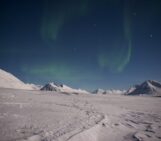In this week’s Imaggeo on Mondays, Bjørn Gitle Hauge – from Østfold University College – opens our eyes to the astounding aurora borealis, and the unusual phenomena seen in Norway’s night sky…
Hessdalen is a former mining district in the middle of Norway with huge ores of copper and mineshafts up to a kilometre deep. The climate here is sub-Arctic, with temperatures reaching as low as -50 degrees Celsius. The last mine was closed in 1988 and unemployment has reduced the number of inhabitants in the valley to less than 140. Towards the north, the night sky over Hessdalen Valley in Norway is coloured green by the aurora borealis. But that’s not all that lights up the night. This remote and desolated area has been the location for an unexplained transient luminous phenomenon for over 200 years.
The priest Jacob Tode Krogh was the first to write of the transient lights in his diaries during the winter of 1811. Erling Strand conducted the first scientific investigation in 1984, and today Norwegian, Italian and French researchers are investigating this obscure phenomenon using equipment permanently deployed at the base of 3 different mountains. Since 1998, field expeditions have been conducted in this area every year. These expeditions are called Science Camps and involve up to 100 researchers and students establishing basecamps in the mountains. This picture was shot during one such Science Camp in 2010, looking up from the dissolute Skarvan Mountain in the middle of the valley with an all-sky camera:

The night sky over Hessdalen Valley Together with the radar an all-sky Nikon D700 camera monitors the whole night sky, covering the same area/view as the radar. The camera is equipped with an 8 mm fisheye lens computer controlled by Nikons Camera Control pro2 software, shooting simultaneous pictures with 30 seconds of shutter opening. (Credit: Bjørn Gitle Hauge via imaggeo.egu.eu)
The clear cold night sky reveals the Milky Way galaxy arm stretching from northeast to southwest. The orange glow in the left of the picture is the lights from the city of Trondheim, 120 km away, and the orange glow in the bottom right is from the city of Røros, 50 km away.
An expedition of 20 men had to carry radar equipment, power-generators, gasoline, computers, radio equipment, cameras and basecamp equipment on their backs to the mountaintop. From there, the radar beam scanned the valley in search for ionized matter (atmospheric plasma), and the camera is looked for sudden bursts of light – electromagnetic energy released from an unexplained ionizing process in the low atmosphere over and in the valley of Hessdalen.
Correlation between optical light bursts and radar echo in the same position/direction may give away evidence of an ionized area in the low atmosphere above us. In this picture you can see a light burst at the bottom right-hand side. This obscures the radar echoes. The light is in the direction of the Berghøgda Mountain, at 1245 m altitude. Since the camera altitude is 1000 m an approximate distance to the light can be estimated at no more than 6 kilometres away – an uninhibited area called Gruvdalen. Gruvdalen is an old mining valley with lots of copper ore. The reason for this phenomenon is still unknown, and we are searching for electromagnetic signatures that can identify its cause.
By Bjørn Gitle Hauge, Østfold University College, Norway
Imaggeo is the EGU’s open access geosciences image repository. Photos uploaded to Imaggeo can be used by scientists, the press and the public provided the original author is credited. Photographers also retain full rights of use, as Imaggeo images are licensed and distributed by the EGU under a Creative Commons licence. You can submit your photos here.



